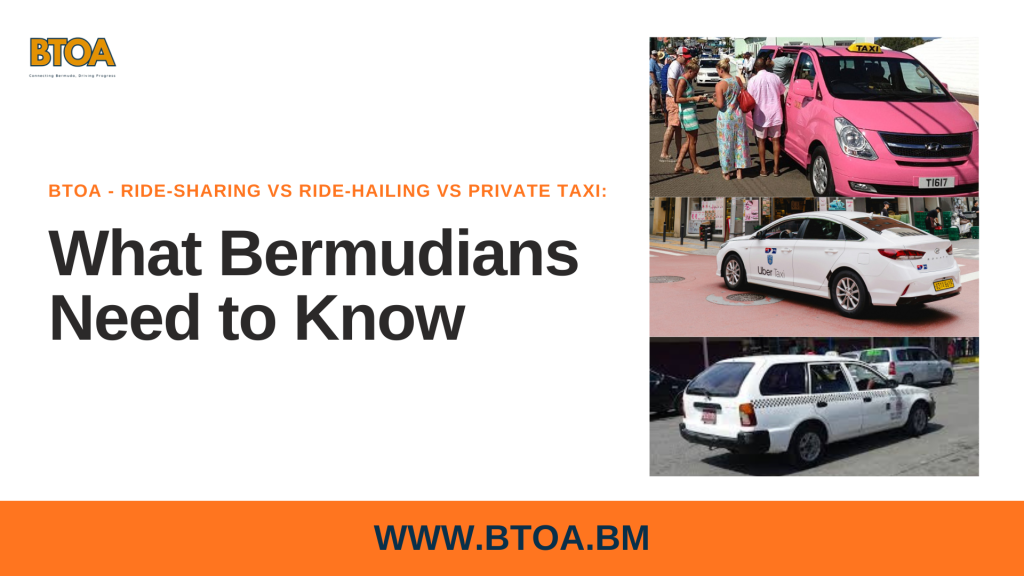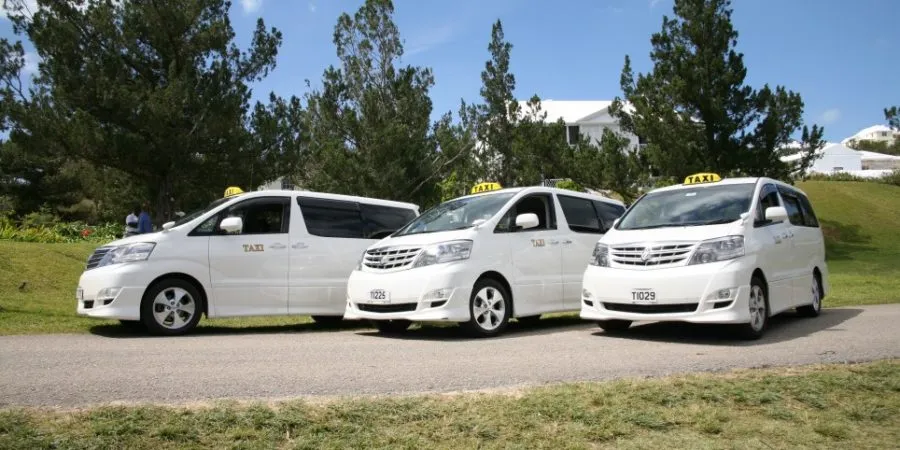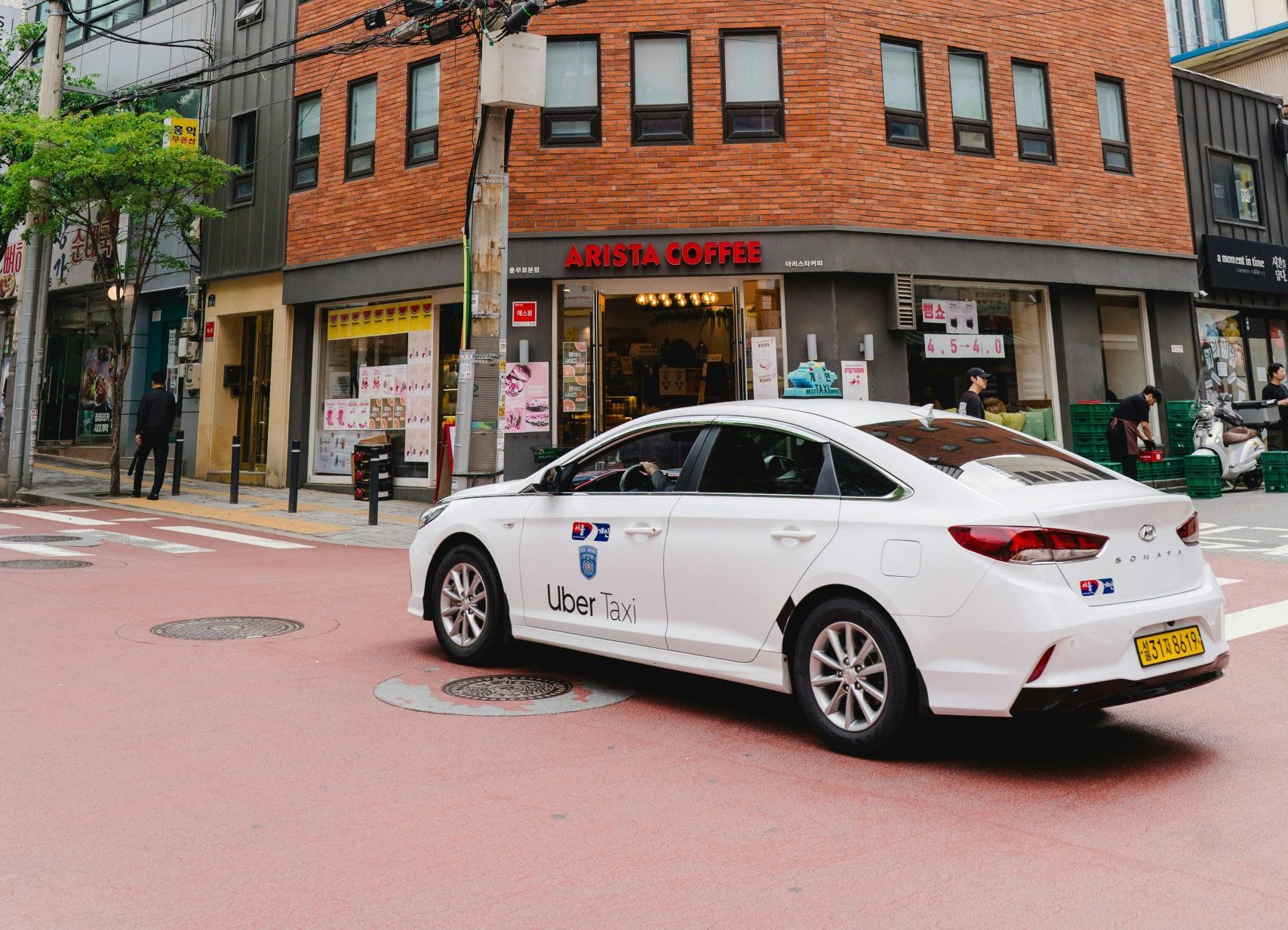Ride-Sharing vs Ride-Hailing vs Private Taxi:
What Bermudians Need to Know by BTOA

When Bermudians hear about “ride-sharing” or “ride-hailing,” the terms can sound almost interchangeable. For most of us who live on the island, our daily reality is simple: if you don’t have your own car, you rely on taxis, minibuses, ferries, or the bus system. But in other parts of the world, transport options look very different.
Travel to Jamaica, the Bahamas, or parts of Latin America, and you’ll find route taxis—cars or vans that run up and down busy corridors, picking up and dropping off passengers along the way. In big cities like New York or London, you’ll see app-based services such as Uber and Lyft, where private car owners take bookings through a smartphone app. And of course, across the globe, you’ll still find the familiar yellow cab or regulated taxi, which operates under a government licence and often through a dispatch system.
At first glance, these options might seem to offer the same thing: someone with a car, someone who needs a ride, and a transaction in between. But the differences run much deeper—especially when you look at safety, insurance, privacy, accountability, and overall quality of service. In Bermuda, those differences matter because our small size, our tourism industry, and our strict transport laws make some models safer and more appropriate than others.
This article will walk through the three models—ride-sharing, ride-hailing, and private taxis—so that Bermudians can understand what’s really at stake when we talk about the future of transport.
What Is Ride-Sharing?
In much of the Caribbean and Latin America, ride-sharing often means shared taxis running along a set route. Locals in Kingston or Nassau might hop into a car that already has three people in the back. The driver follows a general route, stopping when someone waves him down or when a passenger wants to get out.
It’s cheap, it’s accessible, and it works in communities where most people know each other or where incomes don’t allow for private trips. But it also comes with trade-offs:
- Privacy is limited. You’re sharing the back seat with strangers, sometimes squeezed shoulder-to-shoulder.
- Travel time is unpredictable. The car will stop several times before you reach your destination.
- Oversight is light. These vehicles often operate informally, with little government regulation, inspection, or insurance requirements.
For Bermudians used to hailing a taxi and riding in private comfort, the shared-ride experience can feel chaotic and uncertain. And while it’s an accepted part of daily life in many countries, it doesn’t always provide the kind of safety net visitors and locals might expect.
What Is Ride-Hailing?
Now let’s move to the model that has transformed transport in big cities over the last decade: ride-hailing through apps like Uber and Lyft.
Here’s how it works. A passenger opens the app, requests a ride, and is matched with a nearby driver—usually someone using their personal car. The app handles the payment and provides some information about the driver and the estimated arrival time. In some cases, the passenger can even choose between a private ride or a cheaper shared option where they’ll pick up another rider along the way.
The convenience is obvious. But the risks are less visible until something goes wrong.
Studies in the United States have found that ride-hailing services were linked to a measurable increase in road accidents. One report noted a 3% rise in traffic fatalities in cities where Uber and Lyft became widespread. Other reports have tracked alarming numbers of serious safety incidents, including thousands of assaults reported by passengers and drivers alike.
And when accidents do happen, the insurance picture is murky. Many ride-hail drivers only have personal car insurance, which typically excludes commercial use. The platforms themselves often argue they are not responsible until a trip is officially “in progress.” That means there are moments when neither the driver’s personal insurer nor the company’s coverage may fully apply. In plain language, passengers can be left exposed.
The companies also protect themselves with long, detailed terms and conditions. Buried in those documents are disclaimers stating that they are not liable for lost items, damages, or in some cases, even injuries. Customers often have no clear path to make a claim, and disputes are resolved internally through opaque processes.
For tourists in Bermuda—or residents who expect high standards of safety and service—those gaps matter. The glossy app interface may feel professional, but behind it is a system designed to limit corporate responsibility.
What Is a Private Taxi?
Finally, let’s talk about the model that Bermudians know best: the licensed, regulated taxi.
Private taxis, whether the yellow cabs of New York or the classic London black cab, operate under laws that strictly control who can drive, what vehicles can be used, and how customers are protected. In Bermuda, taxis are classified as public service vehicles (PSVs) and are bound by legislation such as the Motor Car Act 1951.
What does this mean for passengers?
- Every taxi must carry passenger liability insurance. If there is an accident, customers are covered.
- Vehicles are inspected regularly. Safety checks ensure that cars meet the standards required to carry paying passengers.
- Drivers are vetted and licensed. That means background checks, exams, and ongoing oversight.
- Fares are regulated. No hidden surge pricing. What you see on the meter or in the official fare table is what you pay.
Accountability exists. If something goes wrong, there is a regulator, an association, and a legal framework to deal with complaints.
Unlike ride-hail drivers who may treat the job as a side hustle, taxi operators are often professionals who dedicate their careers to the industry. In Bermuda, many drivers are also ambassadors, offering not just a ride but knowledge, history, and hospitality to visitors.

Safety: The Core Difference
It is tempting to think of all these systems as interchangeable transport options. But the real dividing line is safety and accountability.
Ride-sharing in other islands can be unpredictable because vehicles are informal and oversight is weak. Ride-hailing apps look modern and convenient, but they often push legal and financial risk onto the driver and passenger.
Private taxis, by contrast, are built on a foundation of legal compliance and passenger protection. In Bermuda, taxis must carry passenger liability insurance—a safeguard that ride-hail platforms often lack. Every driver is licensed through a government process. Vehicles are inspected. Standards are enforced.
For a luxury destination that markets itself on safety, quality, and hospitality, those protections aren’t just nice to have. They are essential.
Bermuda’s Legal Landscape
Bermuda’s laws already draw a clear line. Section 26 of the Motor Car Act 1951 makes it illegal for private cars to carry passengers for hire unless they are licensed as public service vehicles. That means that ride-hail models using ordinary private cars are not legally permitted here.
In 2024, the Government introduced a pilot rideshare programme to test limited operations, but even that required vehicles to hold proper PSV permits and to operate through Bermuda-based dispatch systems. The idea was to modernise without abandoning the core protections of the PSV framework.
Yet the reality is that enforcement has been weak, and the legal framework itself is outdated. Taxi laws written in the 1950s never imagined app-based dispatch, digital monitoring, or real-time safety tracking. There is no system today that records how long a vehicle is on the road, how many jobs are accepted, or whether service levels are meeting public expectations.
This creates a dangerous gap. Without proper reform, Bermuda risks allowing new services to slip through old laws, leaving passengers less protected and undermining the livelihoods of taxi operators who have invested in the system for decades.

Lessons From Abroad
Other countries offer clear warnings.
In London, Uber has faced repeated legal battles, including a £250 million lawsuit from black-cab drivers who argued the company misled regulators and gained an unfair advantage. In U.S. cities, courts continue to debate whether ride-hail drivers are employees or contractors—a question that directly affects insurance, liability, and passenger safety.
Where governments tried to shoehorn new services into old taxi laws without updating the framework, chaos followed. Complaints surged, enforcement struggled, and traditional taxi industries—built by local operators who paid for licences and complied with regulation—were destabilised.
Bermuda should take heed: without thoughtful legislative reform, the same risks could play out here.
Why Private Taxis Are Bermuda’s Best Option
When you compare the three models side by side, the conclusion is clear.
- Ride-sharing may be cheap, but it lacks safety and predictability.
- Ride-hailing offers convenience, but at the cost of accountability and insurance coverage.
- Private taxis deliver safety, professionalism, and regulated standards.
In Bermuda, where tourism is our lifeblood and residents expect high levels of trust and security, the regulated taxi system remains the best, safest, and most premium option. It ensures that every ride is covered by insurance, every driver is licensed, and every vehicle is fit for purpose.
And as technology evolves, the industry is not standing still. The BTOA Connect platform is bringing the convenience of app-based booking to Bermuda’s regulated taxi fleet. Customers can enjoy digital ease without sacrificing the safety net that only a legal, licensed system provides.
Moving Forward
The transport industry is changing fast, and Bermuda must modernise. But modernisation cannot mean cutting corners on safety or undermining an industry that has faithfully served this island for generations.
We need legislation that recognises digital platforms, enforces real accountability, and ensures that all vehicles carrying passengers for hire are properly licensed, insured, and inspected.
Anything less would put passengers at risk and erode the standards that make Bermuda’s transport industry a cornerstone of our hospitality.
As the Bermuda Taxi Owners & Operators Association, our message is simple: innovation is welcome, but safety is non-negotiable. The private taxi model, properly regulated and digitally enhanced, is not only the safest option for Bermuda but the one that protects our community, our visitors, and our reputation.



